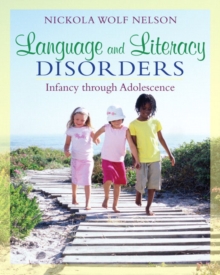| Description: | Organized with a clear framework and student-friendly learning supports, this textbook helps graduate and undergraduate students gain essential knowledge that can inform, and transform, their work with children who need special assistance to acquire language and literacy abilities to meet multiple communication and learning needs. Featuring content and questions that encourage deeper thinking about the nature of disordered and normal development, this text makes assessment and intervention practices relevant to contexts of home, classroom, and peer interactions. In particular, readers will learn to draw on multiple sources of input to develop an assessment picture for a child at any age and stage of development as a person with unique strengths and needs, coming from a particular cultural-linguistic background, and with concerns that may be attributed to a particular known or unknown but suspected set of etiological factors. Additionally, readers will learn to plan interventions that target developmentally appropriate outcomes in spoken and written language and to apply techniques that are informed by varied theoretical perspectives and a growing evidence base. This text is organized into three sections that are designed to promote understanding of: (1) basic concepts, taxonomies, policies, and procedures that can inform other decisions; (2) implications of common etiologies (e.g., primary language impairment/learning disability, hearing impairment, autism spectrum disorders, mental retardation/cognitive impairment; acquired neurological impairment) for modifying assessment and intervention practices; and (3) appropriate assessment and intervention procedures across developmental language and literacy ages, stages, and targets. Instructors can guide students through the sections and chapters, review and practice material, and extended exercises, so students can gain confidence they will know what to do when facing diverse populations of real children in a variety of settings. Although the book is written primarily for students in speech-language pathology, it draws on the author’s experience working in schools and classrooms with general and special education teachers and other interdisciplinary team members and can be used with (or by) members of other disciplines and by practitioners as well as students. The ultimate beneficiaries of this book should be children and adolescents who grow up with improved abilities to communicate, read, write, listen, and speak because they received services from professionals who knew what they were doing and why.
Organised with a clear framework and student-friendly learning supports, this textbook helps graduate and undergraduate students gain essential knowledge that can inform, and transform, their work with children who need special assistance to acquire language and literacy abilities to meet multiple communication and learning needs. Featuring content and questions that encourage deeper thinking about the nature of disordered and normal development, this text makes assessment and intervention practices relevant to contexts of home, classroom, and peer interactions. In particular, readers will learn to draw on multiple sources of input to develop an assessment picture for a child at any age and stage of development as a person with unique strengths and needs, coming from a particular cultural-linguistic background, and with concerns that may be attributed to a particular known or unknown but suspected set of etiological factors. Additionally, readers will learn to plan interventions that target developmentally appropriate outcomes in spoken and written language and to apply techniques that are informed by varied theoretical perspectives and a growing evidence base. This text is organised into three sections that are designed to promote understanding of: (1) basic concepts, taxonomies, policies, and procedures that can inform other decisions; (2) appropriate assessment and intervention procedures across developmental language and literacy ages, stages, and targets; and (3) implications of common etiologies (e.g., primary language impairment/learning disability, hearing impairment, autism spectrum disorders, mental retardation/cognitive impairment; acquired neurological impairment) for modifying assessment and intervention practices. Instructors can guide students through the sections and chapters, review and practice material, and extended exercises, so students can gain confidence they will know what to do when facing diverse populations of real children in a variety of settings. Although the book is written primarily for students in speech-language pathology, it draws on the author’s experience working in schools and classrooms with general and special education teachers and other interdisciplinary team members and can be used with (or by) members of other disciplines and by practitioners as well as students. The ultimate beneficiaries of this book should be children and adolescents who grow up with improved abilities to communicate, read, write, listen, and speak because they received services from professionals who knew what they were doing and why.
|


